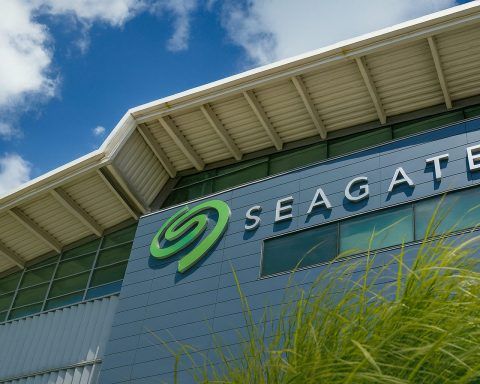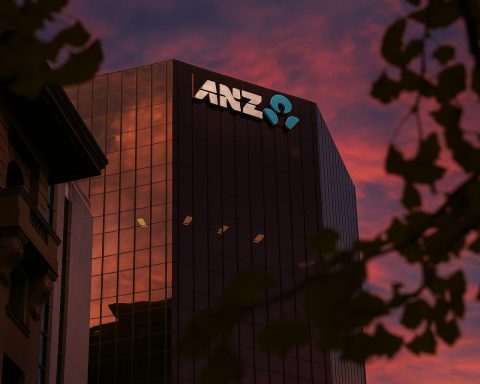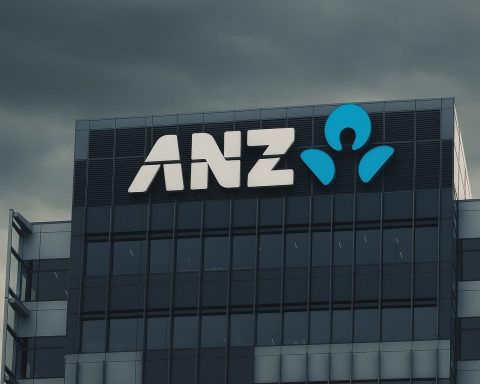ANZ’s boardroom intrigue over its choice of Nuno Matos, a costly cultural overhaul and record fines collide with the high‑stakes climax of the new ANZ Premier League darts tournament in Brisbane.
Australia’s ANZ brand is in the spotlight on two very different stages this weekend. In Melbourne and Canberra, new ANZ chief executive Nuno Matos is trying to convince investors, regulators and politicians that he can fix a troubled banking culture after years of misconduct and record fines. [1]
In Brisbane, the Dabble Darts PDC ANZ Premier League has just crowned its inaugural champion, with Simon Whitlock winning a dramatic Finals Night to secure a return to the sport’s richest event, the Paddy Power World Darts Championship. [2]
Here’s how the stories behind those three letters – ANZ – are unfolding today.
Boardroom backstory: was Nuno Matos really ANZ’s first choice?
A fresh report in The Australian Financial Review this week has reignited debate about how ANZ ended up with Nuno Matos as chief executive. The paper says another “well‑known European banker” came very close to landing the job: former UBS and ING chief executive Ralph Hamers, a high‑profile figure widely known for his digital banking push in Europe. [3]
According to the AFR’s reporting and subsequent commentary, Hamers impressed ANZ’s board during a global search that canvassed candidates far beyond Australia’s shores, before directors ultimately opted for Matos instead. [4]
An article published today by defence‑and‑business outlet SSBCrack News adds further colour to that search, noting that ANZ directors weighed “a variety of candidates” and debated what kind of leader could best steer the bank through regulatory scrutiny and strategic change. The piece highlights that Matos’ appointment followed extensive internal deliberations on whether to prioritise continuity, a known turnaround specialist, or a fresh outsider with global retail banking experience. [5]
The timing of these revelations is sensitive. ANZ’s chair Paul O’Sullivan has already faced criticism over the level of front‑line banking experience on the board, prompting a broader rethink of its composition and renewal. [6]
Who is Nuno Matos? The HSBC veteran now running ANZ
Whatever the debate about first choices, Nuno Matos is now firmly in charge of Australia and New Zealand Banking Group.
According to ANZ’s shareholder centre, Matos was formally appointed chief executive on 12 May 2025, after the board brought forward his start date from later in the year. [7]
Before ANZ, he spent more than three decades in banking, most recently as CEO of Wealth and Personal Banking at HSBC, where he oversaw about 87,000 employees serving around 40 million customers across 35 markets. He previously ran HSBC Bank plc and its European operations, led HSBC Mexico, and held senior roles at Santander in Europe and Latin America. [8]
That CV explains much of his appeal to ANZ’s board:
- Deep experience in mass‑market retail and wealth – crucial as ANZ battles its larger domestic rivals for home‑loan and everyday banking customers. [9]
- A track record in large‑scale transformation across multiple continents. [10]
- Comfort with complex regulatory environments in Europe, Asia and the Americas – something ANZ badly needs after a bruising run‑in with Australian watchdogs. [11]
But that global pedigree has also sharpened scrutiny: if ANZ went to the trouble of running a truly international search – and nearly picked Ralph Hamers – expectations on Matos to deliver a clean break with the past are sky‑high. [12]
Culture on trial: record fines, a profit slump and thousands of job cuts
The stakes around ANZ’s leadership choice are clear in this month’s numbers and headlines.
On 10 November, ANZ reported a 14% drop in annual cash profit, to A$5.79 billion for the year to 30 September – below market expectations. Reuters reported that about A$1.11 billion of profit was wiped out by 3,500 staff redundancies and legal penalties, including a record A$240 million settlement with Australia’s securities regulator ASIC over “widespread misconduct”, from a flawed government bond deal to fees charged to deceased customers. [13]
Matos responded with a tough message to investors:
- ANZ will aim to cut total costs by around 3% in its 2026 financial year.
- The bank is battling intense mortgage competition, with its net interest margin slipping to 1.55%, and needs to “do better” than bigger rivals. [14]
Days later, he was in Canberra facing the House of Representatives Standing Committee on Economics, where he delivered a lengthy opening statement, apologising for past failures and acknowledging that ANZ’s culture and non‑financial risk management had not been good enough. [15]
A Reuters report on the appearance emphasised several key points: [16]
- Since 2016, ASIC has brought 11 civil cases against ANZ, with over A$310 million in penalties.
- A McKinsey review described a “good news culture” where staff were reluctant to raise problems or challenge senior leaders.
- Regulators have imposed extra capital requirements – around A$250 million – to reflect governance and risk‑management weaknesses.
- Matos has already overseen the departure of multiple senior executives and around 3,500 job cuts as part of a broader overhaul.
An AI‑assisted analysis by AInvest this week pulled those strands together, noting that ANZ has now racked up roughly A$490 million in fines and is under heavy scrutiny from both ASIC and prudential regulator APRA. It also notes that most senior leaders associated with the failings are no longer at the bank. [17]
Meanwhile, ANZ’s own annual report – and subsequent Australian media coverage – confirmed that former CEO Shayne Elliott was stripped of a A$13.5 million bonus, and that a total of around A$32 million in executive bonuses has been withheld to demonstrate “severe accountability” for the regulatory mess. [18]
New top team: Matos rebuilds ANZ’s leadership bench
To convince regulators and investors that ANZ really is changing, Matos has been reshaping his senior team.
In October, ANZ announced three major executive committee appointments:
- Pedro Rodeia – a former McKinsey partner – as Group Executive, Australia Retail
- Christine Palmer as Group Chief Risk Officer
- Donald Patra as Group Chief Information Officer [19]
Matos said the trio were “world‑class executives” whose skills in customer experience, risk oversight and technology would be critical to executing the bank’s strategy. [20]
Those appointments sit alongside an earlier board‑renewal process, including the addition of director Alison Gerry, who has deep banking and risk experience in New Zealand and Australia. [21]
From an investor’s perspective, the picture looks like this:
- Short‑term pain: higher one‑off costs, big fines, job‑cut expenses and bonus clawbacks. [22]
- Medium‑term bet: a leaner cost base, simplified structure and (if the culture shift works) fewer nasty surprises from regulators. [23]
As of this week, ANZ shares are trading in the mid‑A$30s, giving the bank a market value of just over A$100 billion and leaving it within striking distance of its 52‑week high, despite the profit drop. [24]
From trading floor to oche: ANZ Premier League darts crowns first champion
While the bank wrestles with its legacy issues, the initials “ANZ” are getting a very different kind of publicity in sport.
The Dabble Darts PDC ANZ Premier League – a brand‑new event run by the Professional Darts Corporation – has just completed its inaugural season, with Finals Night staged today at Brisbane’s Nissan Arena. [25]
The tournament, announced late last year, is part of the PDC’s Global Affiliate Tours and is designed as the biggest darts show ever staged across Australia and New Zealand:
- Eight nights in major arenas across the region, from Melbourne and Hobart to Wellington and the Gold Coast. [26]
- A knock‑out format on each of the first seven nights, mirroring the main PDC Premier League.
- A A$160,000 prize fund, with A$30,000 for the champion and A$24,000 for the runner‑up. [27]
- Crucially, the winner earns a spot at the 2025/26 Paddy Power World Darts Championship at London’s Alexandra Palace. [28]
The PDC struck broadcast deals with Foxtel Group’s Kayo Sports in Australia and Sky in New Zealand to show all eight nights live, a significant boost for darts’ visibility in the region. [29]
Important nuance: In this context, “ANZ” refers to the Australia–New Zealand region, not specifically to ANZ Bank – though the timing means the initials are appearing in both finance and sports headlines at once.
Finals Night drama: Simon Whitlock’s emotional win over Raymond Smith
Today’s Finals Night delivered the kind of storyline tournament organisers dream about.
According to the PDC’s match report, Australian veteran Simon Whitlock produced a vintage performance to win the inaugural title, beating fellow Aussie Raymond Smith 10–7 in the final. The victory secures Whitlock A$30,000 in prize money and, more importantly, a return to the World Championship after missing out last year and ending a 15‑year streak at “Ally Pally”. [30]
Key results from Nissan Arena, Brisbane: [31]
- Semi‑finals
- Raymond Smith 8–2 Tim Pusey
- Simon Whitlock 8–3 Jonny Tata
- Final
- Simon Whitlock 10–7 Raymond Smith
Whitlock, who didn’t win a single nightly event during the league phase, “saved his best darts for the decider”, including a run of seven near‑perfect throws in the closing stages. He was visibly emotional afterwards, telling PDC media that the win “means the world” and gives him a lifeline to chase a world title again. [32]
Smith, who topped the league table heading into Finals Night, admitted the better player won on the night and said he’s still on a long‑term comeback path after recent health issues. [33]
The result has knock‑on effects for the World Championship field as well. Whitlock’s qualification means four Australians are now set to appear at Alexandra Palace:
- Simon Whitlock (ANZ Premier League champion)
- Damon Heta (World Cup of Darts winner)
- Joe Comito (DPA number one)
- Tim Pusey (ADA Tour winner) [34]
Earlier this week, talkSPORT reported that Raymond Smith was planning to turn down a PDC World Championship spot – even if he qualified via the ANZ Premier League – to honour his commitment to the rival WDF World Championship at Lakeside, citing financial and scheduling reasons. [35]
Whitlock’s win renders that dilemma moot for now: the PDC spot goes to him instead, while Smith can continue focusing on his Lakeside campaign.
What it all means for the ANZ brand and the region
The juxtaposition is striking:
- In banking, ANZ is trying to prove that a new CEO, refreshed board and revamped leadership team can clean up years of misconduct, pay back angry regulators and rebuild trust with customers and investors. [36]
- In sport, “ANZ” is attached to a colourful new darts showcase that has filled arenas across Australia and New Zealand, produced a feel‑good story for a local hero and secured another high‑profile spot at the sport’s richest event. [37]
For the broader Australia–New Zealand region, both stories point in a similar direction:
- International capital and regulators are demanding higher standards of governance, culture and risk management from big financial institutions.
- Global sports bodies are investing more heavily in Oceania, with darts joining rugby, cricket and football in treating the region as a serious market rather than a distant outpost. [38]
Key takeaways for 22 November 2025
- ANZ’s CEO search was closer than previously understood. Reports suggest former UBS and ING boss Ralph Hamers nearly got the job before the board backed Nuno Matos, underlining how deliberately the bank sought an external change agent. [39]
- Matos faces a brutal first year. He has inherited a bank hit by almost half a billion dollars in fines, a 14% profit slide, thousands of job cuts and heightened capital requirements – all while being asked to deliver cost cuts and a cultural reset. [40]
- The leadership bench is being rebuilt. New executives in retail, risk and technology, combined with board renewal, show ANZ trying to match its rhetoric on culture with changes in who actually runs the bank. [41]
- On the oche, the ANZ Premier League is already a hit. The inaugural season has delivered big crowds, a strong broadcast presence on Kayo and Sky NZ, and a headline‑friendly champion in Simon Whitlock. [42]
- Whitlock’s win boosts Australia’s presence at the World Championship. Four Australians will now head to London, further cementing the region’s importance in the global darts ecosystem. [43]
As 2025 winds down, ANZ the bank and ANZ the darts tour are both at pivotal early stages of long‑term projects. One is a high‑stakes cultural repair job inside a A$100‑billion financial giant; the other is a new sporting roadshow that may become a permanent fixture on the global darts calendar.
References
1. www.reuters.com, 2. www.pdc.tv, 3. www.afr.com, 4. www.afr.com, 5. news.ssbcrack.com, 6. www.afr.com, 7. www.anz.com.au, 8. www.anz.com, 9. www.reuters.com, 10. www.anz.com, 11. www.ainvest.com, 12. www.afr.com, 13. www.reuters.com, 14. www.reuters.com, 15. www.anz.com.au, 16. www.reuters.com, 17. www.ainvest.com, 18. www.reuters.com, 19. www.anz.com.au, 20. www.anz.com.au, 21. www.anz.com.au, 22. www.reuters.com, 23. www.tradingview.com, 24. www.google.com, 25. www.pdc.tv, 26. www.pdc.tv, 27. www.pdc.tv, 28. www.pdc.tv, 29. www.pdc.tv, 30. www.pdc.tv, 31. www.pdc.tv, 32. www.pdc.tv, 33. www.pdc.tv, 34. www.pdc.tv, 35. talksport.com, 36. www.ainvest.com, 37. www.pdc.tv, 38. www.pdc.tv, 39. www.afr.com, 40. www.reuters.com, 41. www.anz.com.au, 42. www.pdc.tv, 43. www.pdc.tv










